
- Constitution & By-Laws
- Measurement Rules
- Vintage Measurement Rules
- Racing Divisions
- General Racing Tips
- S Curb Jibe
- Improve Your Starts
- Sailing Glossary
- Racing Rules
- This is How I Do It
- Roll Tank Deck System
- Dorr Willey Project
- Charles & Paul Doing It Right
- Little Mae Too Plans 1943
- Louis Pillon Plans
- Cole Super-Moth Plans
- Some Building Tips
- Some Material Sources
- Europe to Europa
- Wax On or Off
- Sail Cleaning Tips
- Dotan Rudder
- Simple Knots


Harry Cates-built Florida design Classic Moth Boat, Nr 2496
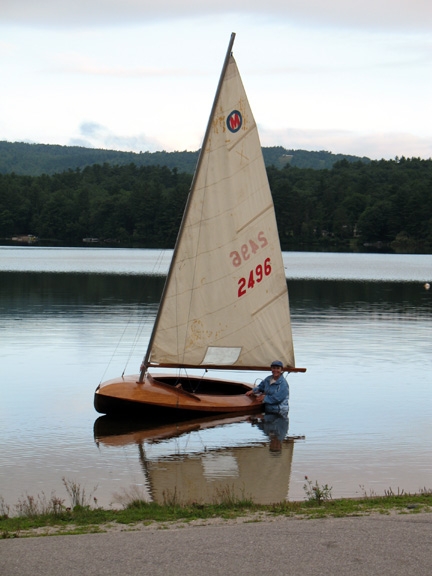
Sun Fun Sailor built from plans in Science & Mechanics Oct 1962
Hi, I wish to advertise and sell my Moth built by my brother in the 1960’s For Sale : Sun Fun Sailor built from plans in Science & Mechanics Oct 1962. Includes trailer and 2 sails. Wood construction hull, mast and boom. Hull bottom was fiberglassed when built in the 1960’s. Located in Appleton Wisconsin. Asking $900.00. Contact Ron Aavang @ This email address is being protected from spambots. You need JavaScript enabled to view it. document.getElementById('cloak2e33eb60090e6553cf07ce7a72757666').innerHTML = ''; var prefix = 'ma' + 'il' + 'to'; var path = 'hr' + 'ef' + '='; var addy2e33eb60090e6553cf07ce7a72757666 = 'raavang' + '@'; addy2e33eb60090e6553cf07ce7a72757666 = addy2e33eb60090e6553cf07ce7a72757666 + 'new' + '.' + 'rr' + '.' + 'com'; var addy_text2e33eb60090e6553cf07ce7a72757666 = 'raavang' + '@' + 'new' + '.' + 'rr' + '.' + 'com';document.getElementById('cloak2e33eb60090e6553cf07ce7a72757666').innerHTML += ' '+addy_text2e33eb60090e6553cf07ce7a72757666+' '; or call cell # (920)904-2167.
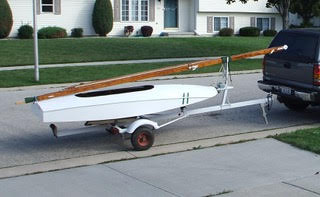
early Ventnor
This is an early Ventnor with an unknown registration number.
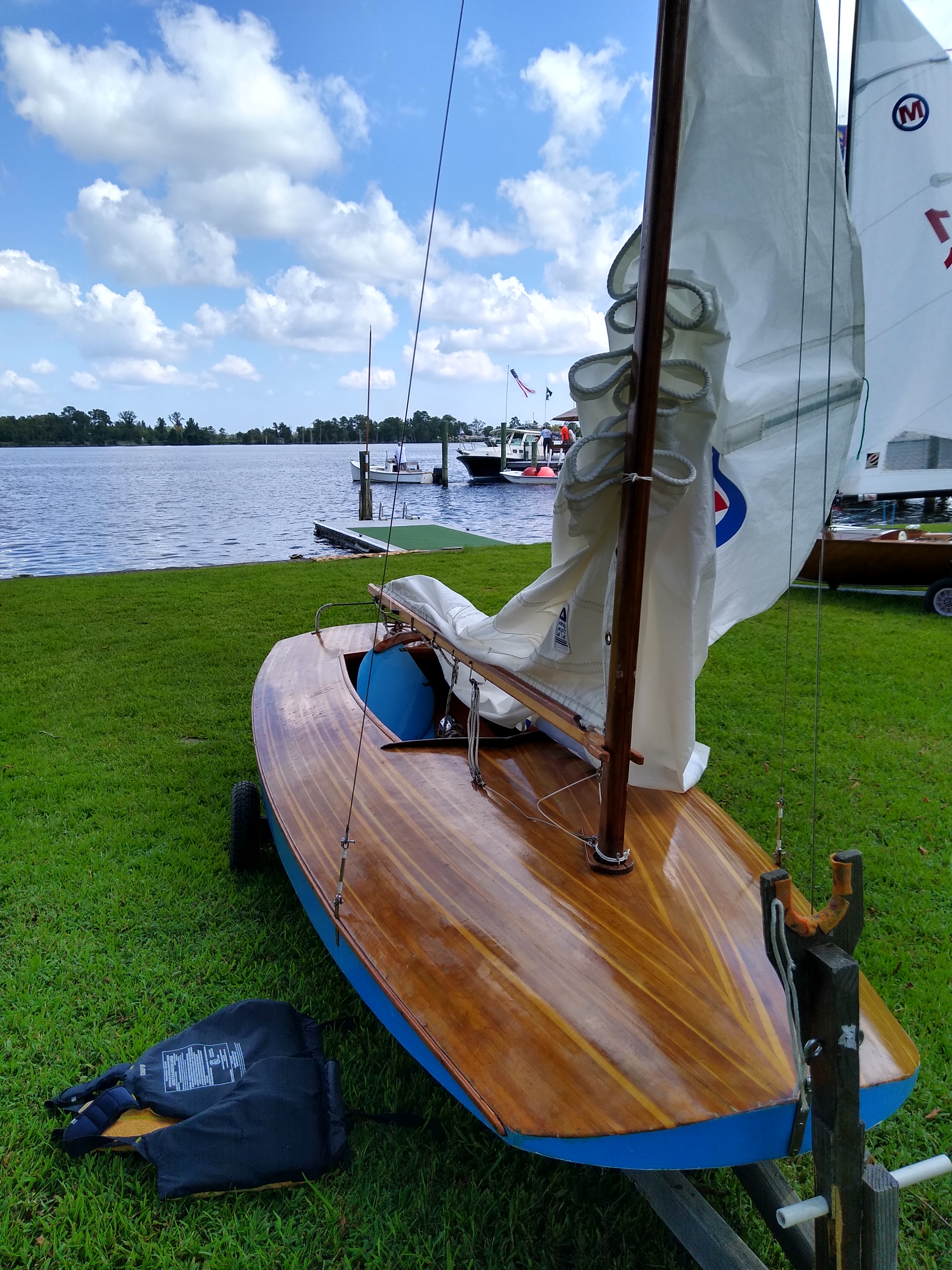
Europe Dinghy in FL
Europe dinghy with
carbon fiber mast, aluminum Proctor boom,
wood dagger board, fiberglass rudder,
Cunningham, vang.
2 sails - practice sail and North racing sail.
Asking $1500.
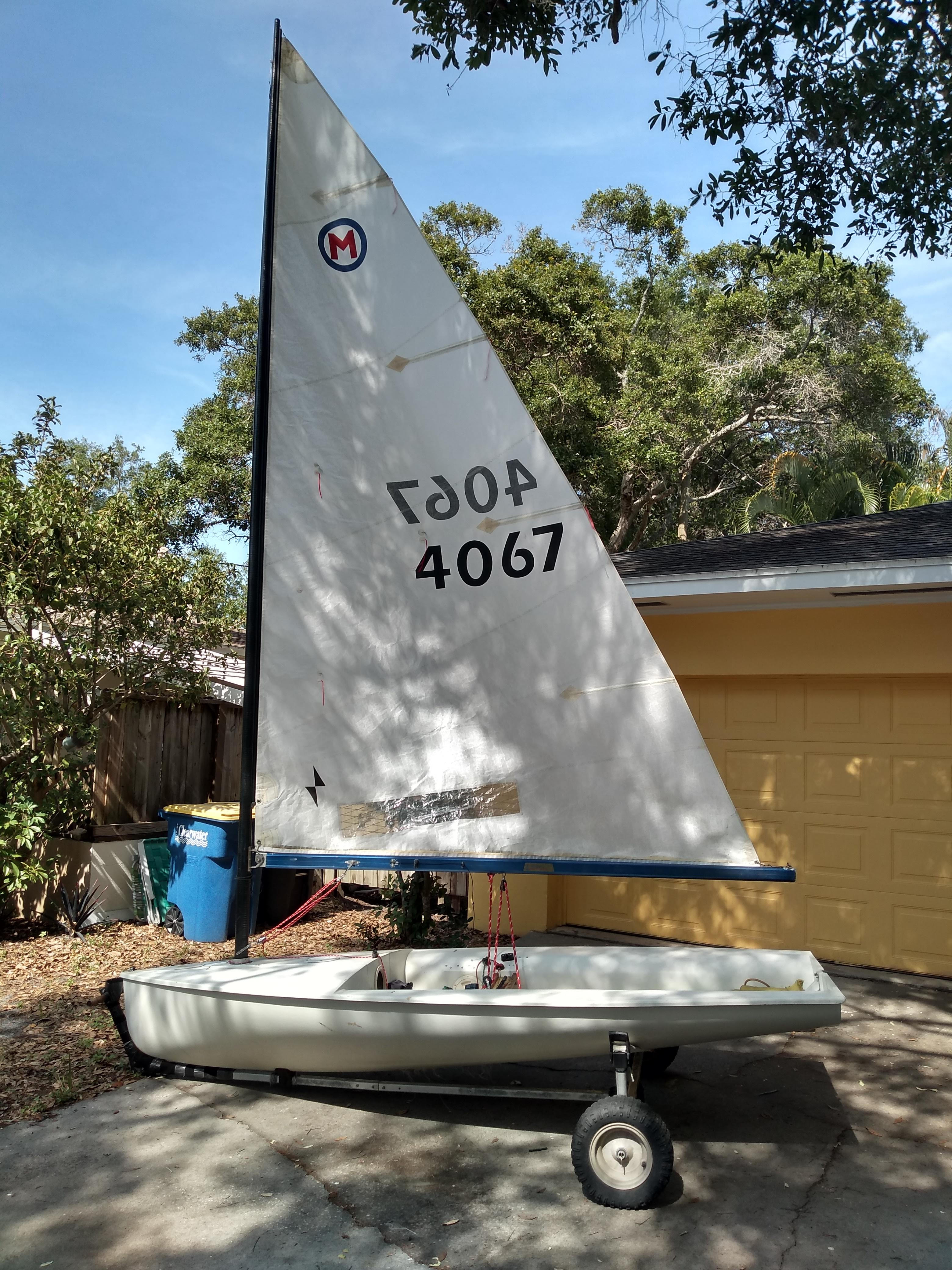
Member Links
- Mid-Atlantic Musings
- Europe Dinghy Moth
- John Shelley's Moth Boat
- Blackberry Boatworks
- Earwigoagin
- The Madmothist
- Classic Moth Boat Facebook Page
Upcoming Events

Welcome to the US Moth Class Association
North americans.
The 2023 Moth North American Championship was held September 14-17 at Sail Newport, RI. Check out one of the highlight videos from the event below and if youre hungry for more, go to Nick Bower's Youtube Channel
The 2024 Moth NAs will be in Southern California in the Fall. Dates and venue TBD

Regional Events
west coast events 2024.
New Years Day Race: Jan 1, SDYC, San Diego
Winter Series #1: Jan 13-14, MBYC, San Diego
Winter Series #2: Feb 17-18, South Bay, San Diego
Moth PCCs: Mar 23-24, CYC, San Diego
Long Beach Training Week: April 7-12, ABYC, Long Beach
Long Beach Spring Classic: April 13-14, ABYC, Long Beach
Ted Rogers Bay Area Championship: May 25-26, RYC, SF Bay Area
High Sierra Regatta: Jul 13-14, Huntington Lake
East Coast Events 2024
Summer Regattas in Newport RI, TBD
US Moth Class Newsletter
We send out a handful of US Moth Class newsletters per year to keep class members up to date on events and logistics. Below you can find the 10 most recent newsletters. To subscribe, open one of the links below and click the "subscribe" button on the top left corner of the page
Getting Into the Moth Class
Moth class usa facebook group.
Joining the US Moth Class's Facebook group is the best way to see what's going on and get involved with the class. Stay up to date with regattas, boat building projects, and general moth froth!
Used Boats For Sale
For many people looking to get into moth sailing, a well setup used boat is the best place to start. Check out the Moth Buy & Sell Facebook marketplace to get a feel for what boats are in your price range and feel free to reach out using to the contact us tool at the bottom of this page if you have questions about what to look for when buying a used boat. Keep in mind that international shipping is easy to arrange using out freight partner!
Shipping/Freight Logistics
One of the coolest aspects of the Moth is the fact it can be disassembled and packed into an 11 foot long box for easy shipping! If you're looking to send your boat to a regatta or buy a used boat and need it delivered, shipping is simple thanks to our freight partner, Saturn Freight Systems. They handle everything from regional ground freight to international air freight. Use the contact us tool at the bottom of the page to get put in contact with a Saturn Freight representative.
Interested in learning more about the US Moth Class? Feel free to reach out!
Thanks for submitting!

- AROUND THE SAILING WORLD
- BOAT OF THE YEAR
- Email Newsletters
- Best Marine Electronics & Technology
- America’s Cup
- St. Petersburg
- Caribbean Championship
- Boating Safety

Bladerider Moth Sailboat
- By Alan Block
- Updated: August 21, 2007
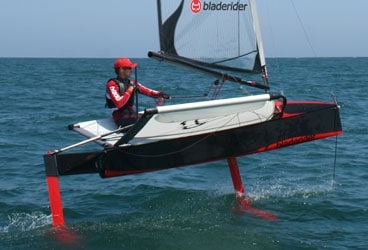
Even the staunchest keelboat devotee can’t help but be intrigued by them. They don’t have a trapeze, and they’ve only got one little sail, yet they sail at twice the true wind speed. They’re monohulls, but they move faster than a Tornado cat, sailing upwind as fast as 13 knots, downwind close to 30 knots. Jumping out of the water on ultra-light carbon foils in a 5-knot breeze, they’ll smoke almost anything else powered by sails.
They’re International Moths, and if Andrew “Amac” McDougall of Bladerider International has his way, they just may change the world of singlehanded dinghy sailing forever.
Ironically, the Moth class that has spawned the most groundbreaking development in hydrofoil technology is one of the ancient ones. Len Morris built his 11-foot Olive near Melbourne, Australia, in 1928. A year later, Joel Van Sant built a Moth in Elizabeth, New Jersey, to almost the same proportions. In both locations the small catboats were a hit, and numbers grew steadily due to the low cost of building such small, simple dinghies.
The class spread from the U.S. to Europe and from Australia to New Zealand, with huge design variations from fleet to fleet. Various national classes modified their rules slightly to encourage international competition, and with the International Yacht Racing Union’s acceptance of the class in 1972, the International Moth Class was born. The openness of the Class Rule, the first sentence of which reads, “the intention of these class rules is to give the designer and builder the fullest liberty in design and construction,” has resulted in much innovation and a variety of designs, including skiff Moths, pram Moths, scow Moths, skinny tube Moths, dinghy Moths, and now foiling Moths (which can be skiff Moths or scow Moths).
In 1999, Australian Dr. Ian Ward opened a can of worms that would change the class more profoundly than any prior development. Ward fitted horizontal hydrofoils to the bottom of the centerboard and rudder of a Moth and he found that the foils lifted the boat out of the water with ease. Catamaran and trimarans had already proven that three T-shaped foils worked, but conventional wisdom held that a dinghy with two foils would be far too unstable to be sailable. Ward quickly found out that the conventional wisdom was wrong, but devising a system to maintain ride height and control would take more time. Brothers John and Garth Ilett created and refined such a system in 2000 using a surface-sending wand to control the main foil’s lift.
Amidst intense intra-class squabbling, Rohan Veal used the Iletts’ creation to win the 2004 Moth World Championship with eight firsts in eight races. In one race, he beat the second place boat by ten minutes. With non-foiling, or “low riding,” Moths quickly approaching obsolescence, the biggest obstacle to competitive Moth sailors became obtaining their own foiling moths. The Iletts’ Fastacraft and a handful of other small, custom boatbuilders just couldn’t keep up with demand for their carefully constructed, all-carbon dinghies. That’s where McDougall came in.
A longtime Moth sailor, McDougall built his first Moth more than three decades ago. In early 2005, he purchases one of the Iletts’ foiling Moths and immediately knew that it was something special, a sailing experience that shouldn’t be constrained by the limited resources of a few custom builders. McDougall scraped up the money for his own Moth design/build business and set to work improving and simplifying existing designs and components to allow faster fabrication and shorter build times. He spent four months on the design of the foils, performing flow analysis and even writing his own foil-creating software. Once he completed the basic boat design, McDougall recruited Veal to help develop and market the boats, signed a partnership with composite specialist McConaghy Boats, and Bladerider International was born.
There are a handful of foiling Moths in the U.S., but the first two production Bladeriders landed here in April via air freight in boxes weighing about 100 pounds. Detroit sailor Bora Gulari bought the second U.S. boat, and in June he took me out for three days of “flight school.” I came late to sailing and started in big keelboats, so I lack the balance and quick reaction time with which lifelong dinghy sailors are blessed. I weigh around 220 pounds, a third bigger than most competitive Mothies, so in a way, I’m the ideal person to test the Bladerider. McDougall’s vision is not to create one more International Moth, it’s to bring the foiling experience beyond the aerospace engineers and tinkerer/athletes to the average sailor–someone just like me. Twenty minutes on the Bladerider taught me that I’ll never win a Moth World Championship, but I experienced a sensation totally new to me, something that could revolutionize the small boat world.
On the first day, moderate winds on a flat Lake St. Clair provided plenty of power, as Gulari proved less than 20 yards from the entrance to Bayview YC when he launched onto the foils and accelerated to 12 knots, upwind. When he turned down to a reach, our Sea Ray could hardly keep up. After a few minutes, I jumped into the water to take my turn. The first thing that struck me was the boom, in the head. The next was the incredible narrowness of the tiny hull. Dwarfed by large, trampoline-covered carbon wings, the 12-inch wide hull resembles a slab-sided torpedo. The designer realized that the hull would spend most of its time in the air, so he downsized it accordingly. The hull is covered with the most aggressive non-skid I’ve ever encountered, and as tippy as the boat is, that’s a good thing. The racks are works of art: clear-coated carbon sculptures covered with Dacron tramps, their width provides massive righting moment to counter the power from the big, windsurfer-inspired sail that sleeves over a thin-walled carbon mast.
Once I got moving, the instability vanished, even before I lifted free of the water. The foils generate substantial lift and stability at slow speeds, giving the pencil-thin hull the feel of a wide boat. Simple sail controls allowed me to concentrate on placing my body where Gulari told me, although the oversized mainsheet made easing the sail a bit stickier than it should have been. It’s a physical boat that requires lots of balance, and the small loads and efficient controls should be attractive to female and youth sailors.
A puff hit, and I practiced the dinghy mantra, “ease, hike, trim.” Hiking on the wing, I trimmed the sail and lifted almost imperceptibly out of the water. Another puff lifted me completely clear, and things went strangely silent. As a Melges 24 sailor, I’m used to going fast, but that speed is always accompanied by spray, vibration, and the sounds of crashing through waves. Speed on a Moth is completely different–drama free, peaceful, almost trance-inducing. Reality broke into my reverie when I let the boat heel too far to leeward. The boat crashed back into the water, and I hit the shrouds.
For days afterwards, my bruises would remind me of just how fast I’d been going.My test sail was like nothing I’d ever experienced on the water. In twenty minutes, the Bladerider opened my eyes to the possibilities of foilborne sailing. Foils have already invigorated the International Moth Class, with membership growth at a ten-year high, but it’s not just the IMCA that Bladerider is trying to revolutionize. McDougall’s operation currently builds three to four boats per week, but to goal is to double that output.
Priced at $14,000, the Bladerider isn’t cheap, but it provides an utterly new experience. Gliding above the water at double digit speeds, the only sound a faint hiss from the foils, you’ll be transformed. Going back to your loud, sloppy, slow, surface-bound craft might just be unthinkable.
For more about the Bladerider Moth, go to www.bladerider.com.au/
- More: foiling , McConaghy , moth , Sailboats
- More Sailboats

Nautor Swan Has A New Pocket Rocket

Pogo Launches its Latest Coastal Rocket

A Deeper Dive Into the Storm 18

2024 Boat of the Year Best Recreational Racer: Z24

One-Design Wingfoil Racing Takes Off

The Wisdom of Augie Diaz

Brauer Sails into Hearts, Minds and History

- Digital Edition
- Customer Service
- Privacy Policy
- Cruising World
- Sailing World
- Salt Water Sportsman
- Sport Fishing
- Wakeboarding
- Sailboat Maintenance Tips
- Eco-Friendly Sailing Practices
- Sailboat Buying Guide
- Sailboat Insurance and Finance
- Sailboat Safety and Regulations
- Sailboat Technology Advances
- Sailing Gear and Equipment
- Sailboat Navigation Essentials
- Sailboat Restoration Projects
- Sailboat Interior Design
- Sailing Destinations Worldwide
- Sailboat Types and Designs

Moth Magic: The Thrilling World of Used Moth Sailboats
1. Unleashing the Potential: Exploring the Captivating Features of Used Moth Sailboats
Used Moth sailboats offer an exhilarating sailing experience that combines speed, agility, and innovation in a sleek design. These high-performance boats are perfect for avid sailors looking to push their boundaries and take their skills to the next level. Let’s delve into the captivating features that make used Moth sailboats a favorite among enthusiasts.
1. Hydrofoiling Technology: One of the most captivating features of used Moth sailboats is their hydrofoiling technology. With retractable hydrofoils attached to the hull, these boats can lift above the water surface as their speed increases. This allows them to achieve unmatched speeds and sail effortlessly, giving sailors a sense of flying on water.
2. Lightweight and Sturdy Construction: Used Moth sailboats are designed with lightweight materials such as carbon fiber , ensuring optimal performance and maneuverability. The hull’s durable construction can withstand intense racing conditions, making these boats suitable for competitive sailing.
3. Adjustable Rigs: Moth sailboats allow sailors to adjust their rigs, making them highly adaptable to different wind conditions. This flexibility ensures optimal sail performance, responsiveness, and control, enhancing the overall sailing experience.

2. Navigating the Waters: Key Factors to Consider When Purchasing a Used Moth Sailboat
When it comes to purchasing a used Moth sailboat, there are several essential factors that every buyer should carefully consider. These factors not only ensure that you make a wise investment but also guarantee that your sailing experience is a smooth and enjoyable one. Here are some key considerations to keep in mind:
- Condition: Thoroughly inspect the boat for any signs of damage or wear and tear. Pay attention to the hull, rigging, foils, and sail. Look for any cracks, dents, or delamination that may affect the boat’s performance.
- Price: Research the current market value of similar Moth sailboats to ensure you are paying a fair price. Take into account factors such as age, condition, and any additional accessories or equipment included in the deal.
- Upgrades and Repairs: Inquire about any upgrades or repairs that have been made to the sailboat. This information can give you an idea of the boat’s overall quality and may affect its value.
- Sailing Experience: Consider your own sailing experience and skill level. Moth sailboats are known for their speed and agility, which may require a higher level of expertise. If you are a beginner, it might be worthwhile to seek guidance from experienced sailors or invest in sailing lessons.
- Documentation: Ensure that all necessary documentation, including registration, title, and maintenance records, are in order. This documentation is crucial for legal ownership and helps determine the boat’s history and maintenance.

3. The Art of Flying: Mastering the Technique of Foiling with your Moth Sailboat
Foiling with your Moth sailboat is like mastering the art of flying on water. It is a technique that requires skill, practice, and an understanding of the physics involved. Once you’ve mastered it, the sensation of gliding effortlessly above the waves is truly exhilarating.
Here are some key tips to help you in your journey of mastering the art of foiling:
- Adjust your hydrofoils: The position and angle of your hydrofoils play a crucial role in maintaining stability and lift. Experiment with different settings to find the sweet spot for optimal performance.
- Find the right wind conditions: Foiling requires a specific range of wind speeds. Too little wind and you won’t generate enough lift, too much wind and control becomes challenging. Pay close attention to weather forecasts and choose your sailing days accordingly.
- Balancing your weight: Foiling involves maintaining a delicate balance between the weight distribution of your body and the sailboat. Shift your weight forward or backward to adjust the angle of attack and maintain stability.

4. Hidden Gems: Top Spots for Thrilling Moth Sailboat Racing and Incredible Experiences
Embark on a quest for adrenaline and unforgettable moments as we unveil the hidden gems for exhilarating Moth sailboat racing and extraordinary experiences. These secret spots are not your regular sailing destinations; they are the playgrounds for thrill-seekers and sailing aficionados looking to push their limits. Pack your bags, grab your gear, and get ready to embark on a journey you will never forget. Brace yourself for heart-pumping action!
Discover the secrets of Moth sailing in stunning locations that will leave you speechless. From the crystal-clear waters of Greece’s Cyclades islands to the picturesque Exumas in the Bahamas, these hidden gems offer the perfect combination of thrilling racing conditions and breathtaking views. Dive into the world of Moth sailing as you navigate through turquoise waters, feeling the power of the wind and the rush of adrenaline.

5. Maintaining the Magic: Essential Tips for Caring and Upgrading your Used Moth Sailboat
When it comes to owning a used Moth sailboat, proper care and maintenance are paramount to ensure its longevity and optimal performance on the water. Here are some essential tips to help you maintain the magic of your beloved Moth:
- Regular Washing: Rinse your Moth sailboat with freshwater after every sail to remove salt and debris that can cause premature wear and corrosion.
- Rigging Inspection: Frequently inspect your rigging for any signs of wear or damage. Look for frayed ropes, broken wires, or loose fittings, and address any issues promptly.
- Protective Covers: Invest in high-quality covers for your Moth to shield it from the elements when not in use. This will help prevent UV damage and keep your boat in optimal condition.
- Upgrading Sails: Consider upgrading your used Moth sail to improve performance and responsiveness. Newer sail technology can make a significant difference in speed and control on the water.
By following these essential care and upgrade tips, your used Moth sailboat will continue to provide you with thrilling adventures and unforgettable moments on the open water. Remember, a well-maintained Moth will not only enhance your sailing experience but also retain its value over time.
Q: What are used moth sailboats? A: Used moth sailboats are sailboats that were previously owned and are now being resold. These boats are specifically designed for competitive sailing and are commonly used in the Moth class racing events.
Q: What makes moth sailboats special? A: Moth sailboats are renowned for their high-performance capabilities and unique foiling design. Equipped with hydrofoils, these boats can “fly” above the water, achieving impressive speeds and thrilling sailing experiences.
Q: Where can I find used moth sailboats -? A: There are several platforms where you can find used moth sailboats -. Online marketplaces, such as dedicated sailing websites, forums, and classifieds, often have listings for used moth sailboats. Additionally, contacting local sailing clubs or attending boat shows can also provide opportunities to find and purchase used moth sailboats.
Q: What should I consider before buying a used moth sailboat? A: When buying a used moth sailboat, it is important to carefully assess its condition, including the hull, wings, foils, rigging, and sails. Check for any signs of damage, wear, or tear. Additionally, consider the age of the boat, its maintenance history, and inquire about any modifications or repairs that have been made.
Q: How much does a used moth sailboat typically cost? A: The cost of a used moth sailboat varies depending on its age, condition, brand, and any additional equipment included. On average, you can expect to find prices ranging from a few thousand dollars for older models to tens of thousands for newer, high-performance boats.
Q: Are there any specific maintenance requirements for moth sailboats? A: Moth sailboats require regular maintenance to keep them in top condition. This typically includes checking and adjusting rigging tension, inspecting and repairing any damage to the hull, wings, foils, and sails, as well as proper storage and transportation to avoid unnecessary wear and damage.
Q: Are there any resources available for beginners interested in moth sailboats? A: Absolutely! There are various online communities, forums, and instructional materials tailored for beginners interested in moth sailboats. These resources provide valuable information about selecting the right sailboat, learning the specific sailing techniques required, and even tips for participating in Moth class racing events.
Q: Can I participate in races with a used moth sailboat? A: Yes, you can certainly participate in races with a used moth sailboat. Moth class racing events often include divisions or categories based on boat age, ensuring fair competition among sailors with both new and used sailboats. It’s a great way to immerse yourself in the thrilling world of moth sailboat racing.
Q: Is it possible to upgrade a used moth sailboat? A: Yes, it is possible to upgrade a used moth sailboat. Many sailors opt to make modifications or improvements to their boats, such as upgrading the foils, rigging, or adding new equipment, to enhance performance and stay competitive. Consulting with experienced sailors or attending workshops can provide valuable insights on how to upgrade your used moth sailboat effectively.
Q: Are there any sailing clubs or communities dedicated to moth sailboats? A: Yes, there are vibrant sailing clubs and communities worldwide that are specifically dedicated to moth sailboats. These clubs often organize races, training sessions, and social events, providing an opportunity to connect with fellow moth sailors, share experiences, and learn from experienced sailors. Joining such a club can help you expand your knowledge and network within the moth sailboat community.
The Conclusion
In conclusion, delving into the world of used moth sailboats reveals a thrilling adventure for sailing enthusiasts. From their nimble and lightweight design to the precision required to harness the wind, these boats have captured the hearts of sailors around the globe. While moth sailing may appear daunting to beginners, the rewards are substantial, offering an exhilarating experience and the potential for personal growth. As you navigate the market for your own used moth sailboat, consider factors such as condition, price, and compatibility with your skill level. Engaging in this exciting sport offers not only a unique way to connect with nature but also a community of passionate sailors who will support you every step of the way. So, embrace the magic of moth sailboats, embark on your sailing journey, and let the wind guide you to unforgettable adventures.
- Recent Posts
- Osprey Pilothouse 24 Fisherman 2000 Boats for Sale & Yachts – Updated for 2023 - April 16, 2024
- Cape Horn 19 CC 2011 Boats for Sale & Yachts Update for 2023 - April 16, 2024
- Explore 24 Pontoon 1986 Boats for Sale & Yachts with a Modern Twist in 2023 - April 16, 2024
Related posts:

LEAVE A REPLY Cancel reply
Save my name, email, and website in this browser for the next time I comment.
Osprey Pilothouse 24 Fisherman 2000 Boats for Sale & Yachts – Updated for 2023
Cape horn 19 cc 2011 boats for sale & yachts update for 2023, explore 24 pontoon 1986 boats for sale & yachts with a modern twist in 2023, bertram flybridge 1981 boats for sale & yachts updated to 2023, cape horn 19 cc 2006 boats for sale & yachts update 2023, more from author.

Quick Links
- Privacy Policy
- Cookie Policy
Popular Articles
- Moth Records
- Rules and Documents
- Meetings and Reports
- Netherlands
- New Zealand
- Switzerland
- United Arab Emirates
About the Boat
The international Moth Class is the fastest one Person Dinghy in the World.
IMCA – Committee
Shaun ritson / chief measurer, graeme southerland and franco greggi / executive committee.
Sponsored by
The Worldwide Leader in Sailmaking
- Sail Care & Repair
- Sailing Gear
- Sail Finder
- Custom Sails
- One Design Sails
- Flying Sails
- New Sail Quote
- 3Di Technology
- Helix Technology
- Sail Design
- NPL RENEW Sustainable Sailcloth
- Sailcloth & Material Guide
- Polo Shirts
- Sweaters & Cardigans
- Sweatshirts & Hoodies
- Accessories
- Mid & Baselayers
- Deckwear & Footwear
- Luggage & Accessories
- Spring Summer '24
- Sailor Jackets
- Maserati X North Sails
- NS x Slowear
- Sailor Jacket
- Sustainability
- North Sails Blog
- Sail Like A Girl
- Our Locations
- Icon Sailor Jacket
- North SUP Boards
- North Foils
- North Kiteboarding
- North Windsurfing
SAIL FINDER
SAILING GEAR
COLLECTIONS & COLLAB
COLLECTIONS
WE ARE NORTH SAILS
ACTION SPORTS
Popular Search Terms
Collections
Sorry, no results for ""
INTERNATIONAL MOTH SPEED GUIDE
Moth Dinghy expert Rob Greenhalgh introduces this extraordinary singlehanded foiling dinghy and describes the keys to sailing one fast.
Who sails the foiling Moth Dinghy?
The Moth class is for everyone—it’s so exciting, you don’t need to race it. Club sailors can get a huge buzz out of foiling, going fast around the bay, and learning to foil jibe and tack. They might enjoy it so much they never need to join a race. At the other end of the spectrum, there are sailors who have been in Moth Class for a decade or more and love the challenge of racing this exciting, complex craft.

Viewed from stern or bow, the foiling moth is a high-speed machine, clearly unlike other sailboats.
What kind of sailors enjoy this challenge?
Moths are development boats, not a strict one-design class, and that’s daunting for some. The technical and evolutionary side of Moth sailing requires a good understanding of how everything works—how the foils interact with the rig setup and how to balance both aspects. Over the last five years, there have been massive speed advancements, which will continue. To be at the top of the game, you have to enjoy the technical side. But you can buy equipment off the shelf and, if you practice and sail well, soon be up to pace. Though more technically oriented sailors often gain an edge for a while, there are also lots of people who will make changes that don’t help them, so it evens out.
How physical is the sailing?
When you are first getting into it, Moth sailing seems physically hard, but once you’ve done it a while, it’s not too bad. On a windy day with a lot of capsizing, it gets pretty tiring. But it’s a light boat, and the loads are not high. Anyone can do it if you can move quickly at times. There are plenty of Moth sailors in their 60s.
New boats or used, which are better?
My advice for the first-time or second-time buyer is to look for a good second-hand boat that you know will fly. This saves you a lot of effort, because even experienced Moth sailors need a few months to work up a new boat. Sure, it’s always a worry that you might not be getting good enough kit with a used boat, but in my experience, any modern Moth can be made fast. If you want to buy new, a standard boat from either of the two main builders—Exocet by Maguire Boats, or Mach 2 by MacDougall McConaghy—will quick enough for top 5. You can also have a look at the new Bieker Moth by LSF Composites.
The Moth is a development class. What’s happening lately?

The Vi-8 DS 3Di (on top) and Vi-8 LA 3DI feature the same sail area. The LA has more power in lighter winds to foil more quickly; the DS has less drag at high speeds.
What sails do you recommend?

8LA-3Di provides extra power to get on foil.
Which sails do you use?

The decksweeper (Vi-8 DS 3Di) creates an endplate and lowers aero-drag. It is slightly faster once foiling.
How does foil choice affect sail choice?
Moths have two foils, a larger foil for lighter winds and a smaller foil for stronger, and that’s a choice you have to make on the beach. In my case, if I expect to be on my foils all day, I’ll choose the smaller foil and the deck-sweeper sail. If the winds are lighter or less reliable, I will often choose the big foil and the LA sail. And if I expect light air to start but a building breeze all day, I’ll likely choose the big foil with the deck-sweeper sail.
Tuning the Moth Dinghy
What are the keys to tuning a moth.
Generally speaking, you should set up your boat to carry as much rake as possible. How much is that? You’ll know it’s too much if you can’t get under the boom in tacks and jibes. This is not something you do underway, and if the boom is making boat handling more difficult, make the rig more upright until that smooths out.
What other key adjustments do you make before launching a Moth?
Batten tension is one. For Batten 1 (the top batten) down to Batten 5, just take the creases out of the batten pockets—don’t over-tighten them. For Batten 6, remove the crease and then add two more turns by twisting the batten key two full revolutions in a clockwise direction. For Batten 7, take the creases out and add three turns. The outhaul is also non-adjustable underway. Rig the boat ashore with the outhaul loose. Pull on max vang and max cunningham, and then pull the outhaul tight. This will give you a good all round setting.
What other settings can you recommend?
Here some of the numbers from my boat, but don’t worry if your measurements are different. Comparing measurements boat to boat may not matter at all. The important thing is to start recording them and experimenting.
- Front Prodder 340 (adjustable +/-50mm)
- Side Arm 410mm
- Deflection 220mm
- Shroud Base 1500mm
- Mast Length 5100mm (excluding plastic plugs top and bottom)
- Back of mast to clew ring 2340mm
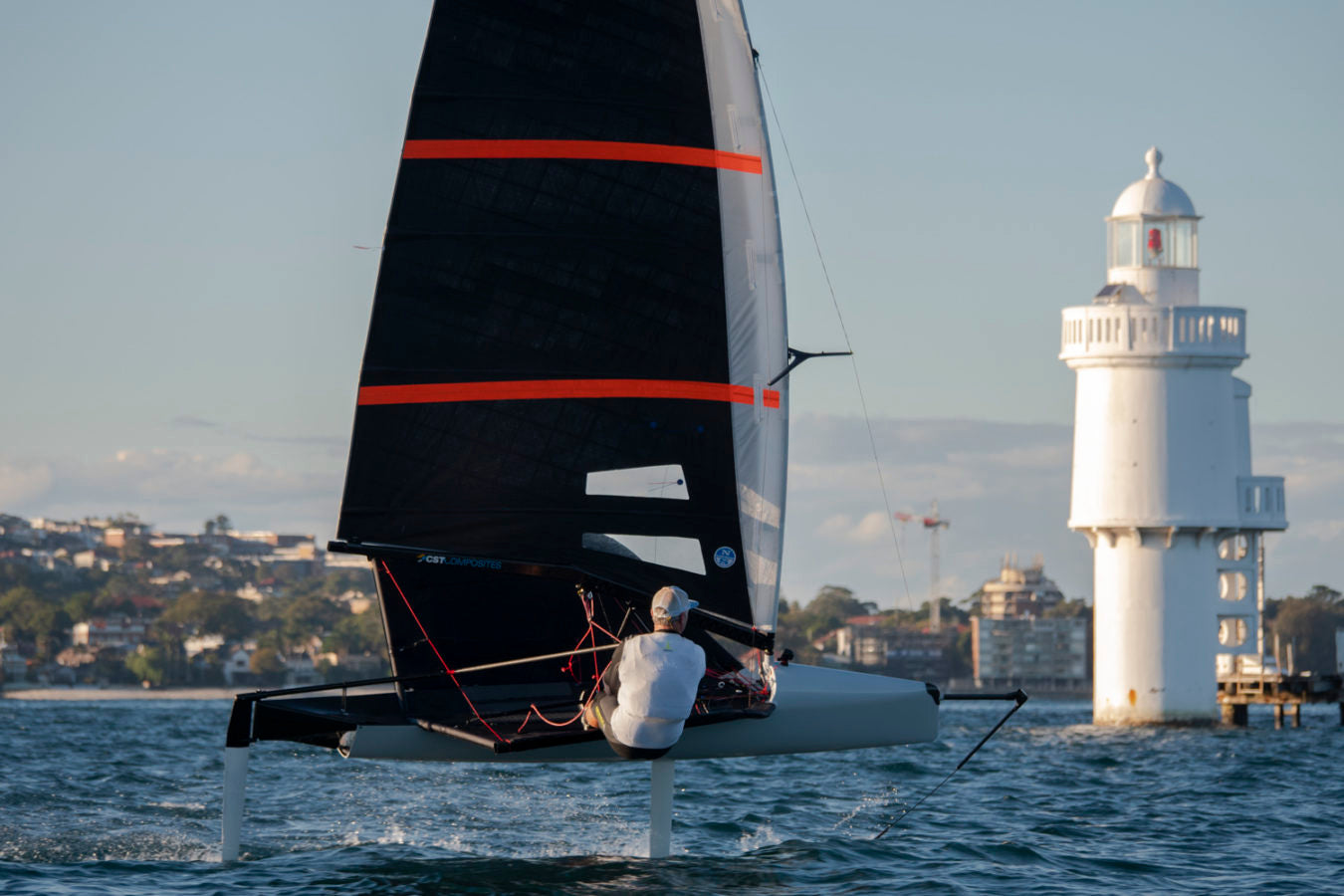
From mast length to shroud base, it's important to record all of your boat and rig measurements. You will change them over time.
How do you set up your foils, actuator wand, and gearing?

Sailing in rougher water requires faster gearing between your actuator and main foils. Foil gearing is a critical control for waves; make sure it can be adjusted for rough waters. To get through waves you need faster gearing. You’ll also change foil size depending on the wind forecast. I have two sets of main foils and use the smaller one on windier days. However, if the wind is light for the first race and predicted to build, I’ll go with the larger foil because the speed penalty of not being able to fly with other boats can trumps all other considerations.
Upwind Moth Sailing
What is most important when sailing upwind.
On any point of sail, the vang and cunningham are powerful controls, and need constant adjustment for different conditions. The goal is to generate power for low-riding and to get up on the foils, and then flatten the sail as the wind builds. One of the challenges of the Moth is it has a maximum 8.25 square meters of sail area, and upwind in most conditions, that’s more sail than you need. Downwind, you have the opposite problem; your speed reduces the apparent wind so much, you’re always starved for power.

What is low-riding mode and how do you sail fast in light winds?
In general you don’t race in winds when you can’t foil, but it may happen that the wind lightens up substantially during a race. Sailing in low-riding mode is an art in itself, something like balancing in a canoe because the hull is so narrow. I always recommend practicing sailing that way.
What does it take to fly a Moth?

Heel the Moth to windward to keep the boat more stable and reduce leeway.
Why do you tip the Moth to windward when flying?
We sail with the rig always tipped to windward because it keeps the boat more stable and reduces leeway on the main foil. Use very subtle steering and trimming of the main.
How do you trim the Moth sailing upwind?
Correct trim is the absolute key to good boatspeed. It’s very easy to over-sheet and stall the front of the mainsail. Always have the inside tell tales lifting. A common mistake is sailing under-powered and over-trimmed. As the wind increases, flatten the main by tightening vang and cunningham to accommodate the higher apparent wind speeds.
How do you adjust sail trim for gusty winds?
You need your rig set-up to be user friendly. That means having enough vang and cunningham to straighten the sail. If twisted, the center of effort can move up and down the sail. It takes a certain level of confidence to get to the point where you can let go of the mainsheet to tighten the kicker and cunningham.
Downwind Moth Sailing
What is the key to good moth speed downwind.

Sailing downwind, be sure to maintain a big entry angle in the lower part of the sail and avoid over-trimming.
What is your focus when trimming downwind?
I focus closely on my lower tell tales, keeping them flying 100 percent and making sure I ease enough to keep the sail ‘hooked up’ with airflow attached. I look for a nice big entry angle on the bottom part of the sail and clean up any horizontal creases by subtly tightening the cunningham. From there, it’s a matter of very subtle trim and steering. If in doubt, ease the sheet and be sure you have good flow going around the front of the sail. If you run into a light patch, just head up to keep the flow going on the main. If needed, power up the main even more. Get the gearing really slow on your foils to minimize drag. The boat will go faster and apparent wind will increase, moving the wind forward and letting you trim harder. Especially when it’s a bit lighter downwind, be sure to pre-empt a drop in apparent wind by easing main and bringing the bow up!
Moth Tacking, Jibing And Gear Changing
How do you foil jibe a moth.

When foil tacking or jibing, you need to flatten the boat. For jibing, bank into the turn to leeward. You’ll turn the boat more aggressively when your body is ready to move across to the new wing.
How do you foil tack a Moth?
When tacking you have to move quickly, bringing the boat relatively flat once head to wind. Start luffing slowly, taking the edge off your speed; make sure the boat is flat when head to wind. As my body moves across the middle to the new wing, I’ll increase the rate of turn, steering quite aggressively through the eye of wind, but my body has to be ready to cross the boat and receive the power on the new tack. You need to come out tipped to windward. Here’s how I break it down:
- Ten seconds before tacking, consider slowing the boat slightly and sailing slightly higher.
- Plan for a slow luff head to wind, followed by a faster turn rate once confident that crew weight can be positioned correctly.
- Heel to windward before the tack but flatten the boat once head to wind. Move your weight inboard. It is important here to sheet the mainsheet on centerline so that it is not over the leeward wing when you pass underneath.
- As you move across the middle of the boat, pass the tiller extension around the back and into a position halfway along the leeward wing.
- When you are confident you can move to the new side, increase the rate of turn, landing on a wider than close-hauled course.
- There are a lot of G-forces during this period, so expected to get ejected a few times!
- Don’t try to piece the whole tack together immediately. Practice the first phase of luffing head to wind, getting your weight to center, and switching the tiller extension across.
- Remember to ease mainsheet out of the tack and have your hands positioned so that the sheet can be eased quickly. The sheet is more important than the tiller on exit.
- I set my mast rake to allow 70 to 75cm between the boom and the deck where I cross the boat. Tacking is important, so make sure you have room under the boom! For tacking practice, I recommend having the rig more upright.
- Don’t adjust any control lines right before or after tacks, unless it is very light and foiling is marginal.
Name 5 key gear changes in a Moth
- To foil early in light air, power up by having the vang and cunningham as loose as possible. However, it is easy to over-deepen the front of the sail, requiring further bear-away to get good flow on the sail. Don’t overdo it.
- Downwind always requires a deeper sail shape than upwind, regardless of wind speed.
- Once foiling, immediately pull on vang to stabilize the sail and cunningham to clean the creases. Even though the wind is light, we are quickly doing 14/15kts. The AWS is high so we need to change sail shape to achieve good speeds.
- As the breeze builds, constantly increase vang and cunningham loads to achieve the desired sail shapes. Max vang should be achieved in 15 knots and max cunningham in 18 knots.
- The Moth gets overpowered quickly, and from 18 knots upwards a softer tip or different sail is required. North’s LA and DS designs have a slight variation in the luff rounds to cover the range, with the DS being aimed at 14 knots true wind speed. For lighter sailors, a softer-tip allows the mast to bend earlier and depower the sail.
How do you start a race in a Moth?
Starts are a bit chaotic. Even for long-time racers, a Moth start will be a new experience. People get up on their foils with about 25 seconds to go and do a big turn-up at about 3 seconds, crossing the lining at 20 knots. A key thing when you’re on your foils is to have the ability to slow down while maintaining control. You need to practice that. Getting to the pin too soon is dodgy, especially with boats starting on port tack.
Why do so many Moths start on port tack?
Moths travel at 15 to 18 knots upwind, so tacking is a very costly part of an upwind leg. Reducing the number of tacks during a beat is very efficient, although this depends somewhat on how well you tack and how confident you are in making your tacks.
How many ways can you capsize a Moth?
You will capsize a Moth every possible way when learning. But I can sail for days now without capsizing, unless it is windy and choppy. The key to recovering quickly is to get on the daggerboard and do a dry capsize, climbing back over the wing. Sometimes that’s hard to do, especially when you pitchpole and find yourself 20 meters out in front of that boat.
What is the most common boat-handling mistake in a Moth?
Capsizing! Foil tacking, in particular, is very difficult. A common mistake is trying to foil tack when it’s breezy. Drag is so high that as you go through head to wind, everything slows down and it’s easy to capsize. You may be better off planning to do a touch-and-go tack.
FEATURED STORIES
Pursuing perfection: tom gillard and the one design team, a visionary sail designer | gautier sergent (1977-2024), how to care for your foul weather gear.
- Refresh page
@media screen and (min-width: 70em){.css-1c47y9x{color:var(--chakra-colors-blue\.brand);}} Moth Foiler buy/sell second hands, ads and prices
Here is the Moth foiler market, Bladerider, Mach2, Mistress and Moth Rocket!
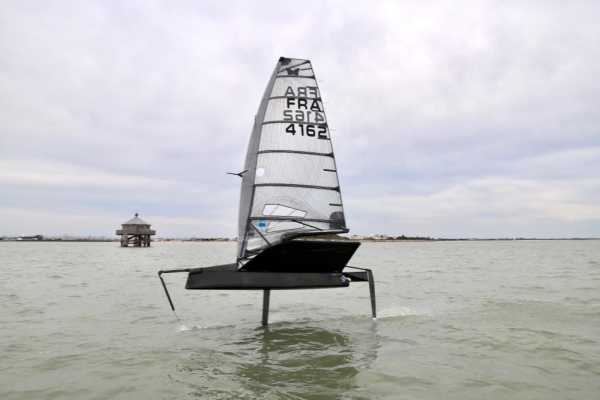
the last Moth Foiler ads at the best price
Moth International McConaghy Boats for sale in Les Sables-d'Olonne
Moth International Aardvark Tech for sale in Calais
Moth International McConaghy Boats for sale in Saint-Malo
Moth International Autre marque for sale in Croissy
Moth International Autre marque for sale in Neufchâtel-Hardelot
Moth International McConaghy Boats for sale in Calais
Moth International Mackay Boats for sale in Niort
Moth International Other brand à vendre à Londo
Moth International Autre marque for sale in Quend
Moth International Aardvark Tech à vendre à Londong
Moth International Autre marque for sale in Moisson
Moth International McConaghy Boats for sale in Saint-Pierre-Quiberon
Moth International Other brand for sale null
Moth International - MACH2 for SALE
Moth International Erplast for sale in Annecy
Moth International McConaghy Boats à vndre à Perth
Some figures of the Moth Foiler sailing dinghy :
Min price :
Max price :
Average price :
Median price :
Available boats :
Launch year :
Used Moth Foiler price table
Moth foiler presentation, the foiler: a moth on steroids.
The Moth foiler is the non-Olympic boat that brings together the highest level of racing. It is an extremely fast, demanding, technological boat. All the America's Cup racers train in Moth Foilers.
Moth Foiler prices and market
Very expensive when new, these boats drop in price quite quickly because the designs become outdated quite quickly. Soon, a hull can no longer shine at a high level.
However, Moth foilers are still very expensive boats, without talking about price per kg!
Great choice! Your favorites are temporarily saved for this session. Sign in to save them permanently, access them on any device, and receive relevant alerts.
- Sailboat Guide
Moth (International)
Moth (International) is a 10 ′ 11 ″ / 3.4 m monohull sailboat designed by Open starting in 1928.
Rig and Sails
Auxilary power, accomodations, calculations.
The theoretical maximum speed that a displacement hull can move efficiently through the water is determined by it's waterline length and displacement. It may be unable to reach this speed if the boat is underpowered or heavily loaded, though it may exceed this speed given enough power. Read more.
Classic hull speed formula:
Hull Speed = 1.34 x √LWL
Max Speed/Length ratio = 8.26 ÷ Displacement/Length ratio .311 Hull Speed = Max Speed/Length ratio x √LWL
Sail Area / Displacement Ratio
A measure of the power of the sails relative to the weight of the boat. The higher the number, the higher the performance, but the harder the boat will be to handle. This ratio is a "non-dimensional" value that facilitates comparisons between boats of different types and sizes. Read more.
SA/D = SA ÷ (D ÷ 64) 2/3
- SA : Sail area in square feet, derived by adding the mainsail area to 100% of the foretriangle area (the lateral area above the deck between the mast and the forestay).
- D : Displacement in pounds.
Ballast / Displacement Ratio
A measure of the stability of a boat's hull that suggests how well a monohull will stand up to its sails. The ballast displacement ratio indicates how much of the weight of a boat is placed for maximum stability against capsizing and is an indicator of stiffness and resistance to capsize.
Ballast / Displacement * 100
Displacement / Length Ratio
A measure of the weight of the boat relative to it's length at the waterline. The higher a boat’s D/L ratio, the more easily it will carry a load and the more comfortable its motion will be. The lower a boat's ratio is, the less power it takes to drive the boat to its nominal hull speed or beyond. Read more.
D/L = (D ÷ 2240) ÷ (0.01 x LWL)³
- D: Displacement of the boat in pounds.
- LWL: Waterline length in feet
Comfort Ratio
This ratio assess how quickly and abruptly a boat’s hull reacts to waves in a significant seaway, these being the elements of a boat’s motion most likely to cause seasickness. Read more.
Comfort ratio = D ÷ (.65 x (.7 LWL + .3 LOA) x Beam 1.33 )
- D: Displacement of the boat in pounds
- LOA: Length overall in feet
- Beam: Width of boat at the widest point in feet
Capsize Screening Formula
This formula attempts to indicate whether a given boat might be too wide and light to readily right itself after being overturned in extreme conditions. Read more.
CSV = Beam ÷ ³√(D / 64)
Single handed development class that has always been at the cutting edge of performance racing dinghies. The MOTH, raced today (2015), at the top tier of competition is a ‘foiler’ with wings.
Embed this page on your own website by copying and pasting this code.
- About Sailboat Guide
©2024 Sea Time Tech, LLC
This site is protected by reCAPTCHA and the Google Privacy Policy and Terms of Service apply.

- CLASSIFIEDS
- NEWSLETTERS
- SUBMIT NEWS
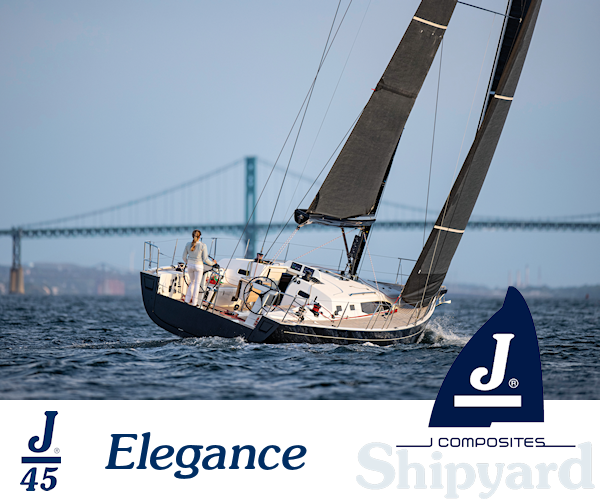
How to home-build a Moth - James Sainsbury's step-by-step guide!
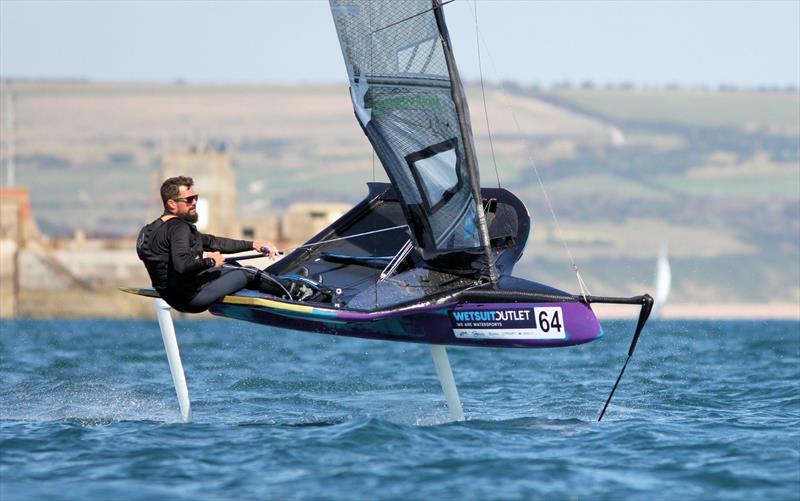
Related Articles
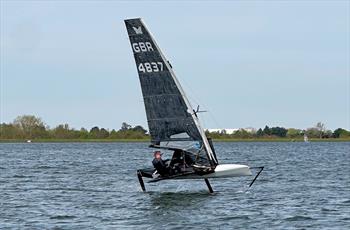

Swift Hydrofoils
Damic Design specialises in design and manufacturing of Moths and Hydrofoils for the International Moth Class. While Moth sailing is our passion, our main objective is to offer the fastest, most developed and best built boats and foils on the market.
Our involvement in the class started in 2004, exposing us to the world of Moth hydrofoiling technology since the early days. The initial period was quite experimental, but also fun and educational as it allowed us to learn and develop our design ideas. We made a lot of foils in this phase with the most successful being the Macita that won the 2013 World Championship. While this foil is not on offer anymore, it certainly paved the way for the foils we make today.
In particular, the Swift range which consists of a number of sizes, each with different lift and control characteristics designed to ensure optimal performance over a wide range of sailing conditions. This range has now grown to include: Two rudders hydrofoils (Small and Medium), three mainfoils (Super Small, Small and Large) and our super thin HM carbon verticals.
The Swift Hydrofoil range is a refined product line with the foils now in their 3rd generation of improvements. We are constantly looking to make gains that we first test, and then bring into production.
What this means for you is that every product in the range is on trend and offers performance improvements for your boat without the need to upgrade the entire platform. While this range is sold with our Swift Moths, it is also available to Bieker, Exocet and Mach 2 owners that are looking for a fast upgrade option. Our foils placed 7 out of the top 10 at Perth Worlds, won 2023 NSW and Australian Nationals and also got 2nd in the Waymouth Pre-Worlds regatta. Furthermore, all Damic Design foils are made in Australia and are constructed from solid carbon fibre, from market leading supplier, Toray. While this increases production costs we believe it is warranted as it insures superior quality and perfomance on what we consider as the most important part of the boat. We are also proud to be the only foil manufacturer that is solely focused on foil development and directly involved in design, testing and manufacturing of all of our products. That means that every foil that leaves our workshop has been hand finished by the designer and Moth sailor that truly understands the product and what is required to make it go fast!
Swift Mainfoils
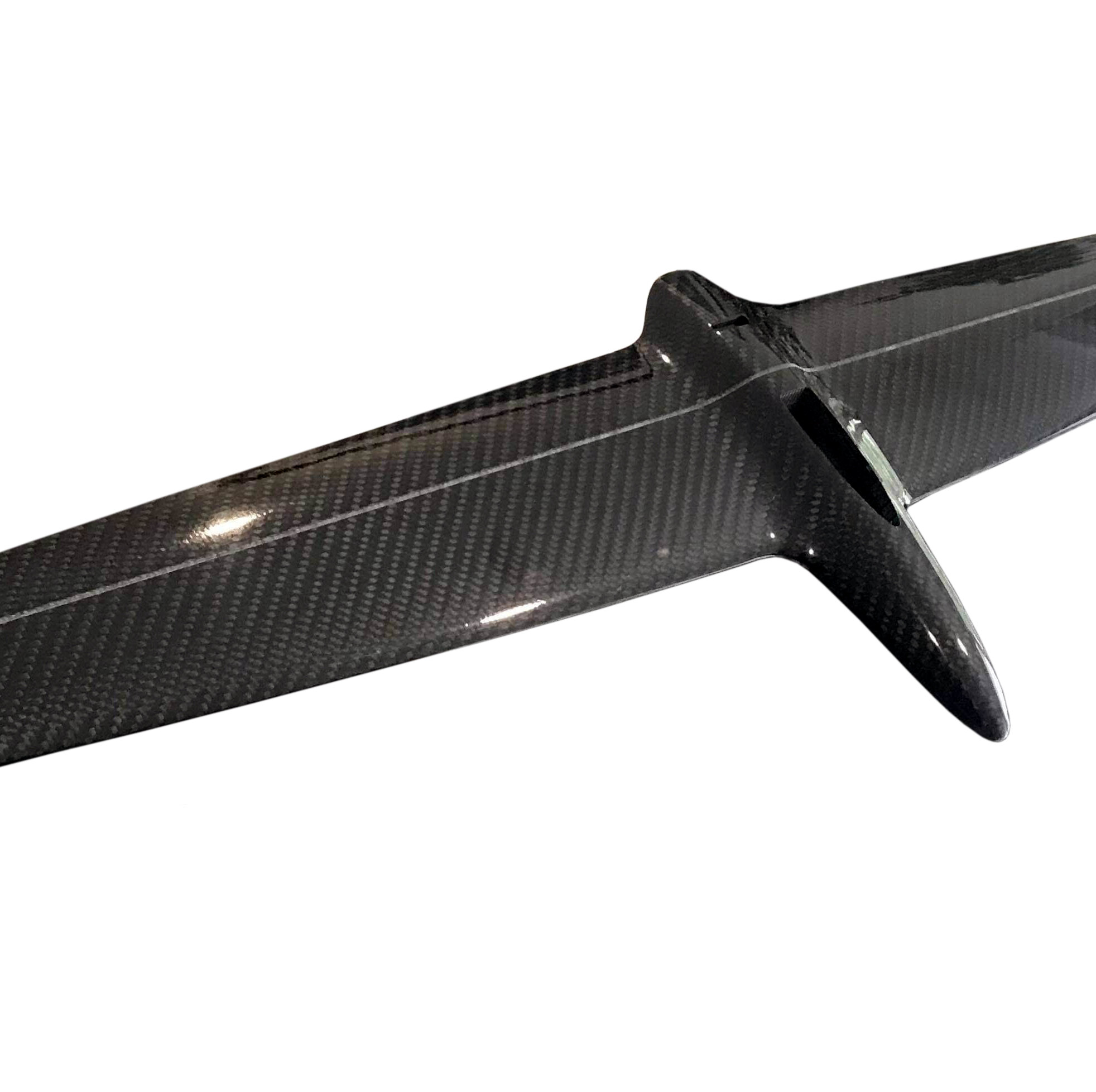
Swift Super Small (v2)
Our latest hydrofoil, specifically designed for light sailors or as a strong wind foil. It features an innovative tip and bulb design that are optimised for reducing drag when going fast.
$3,350 AUD + GST
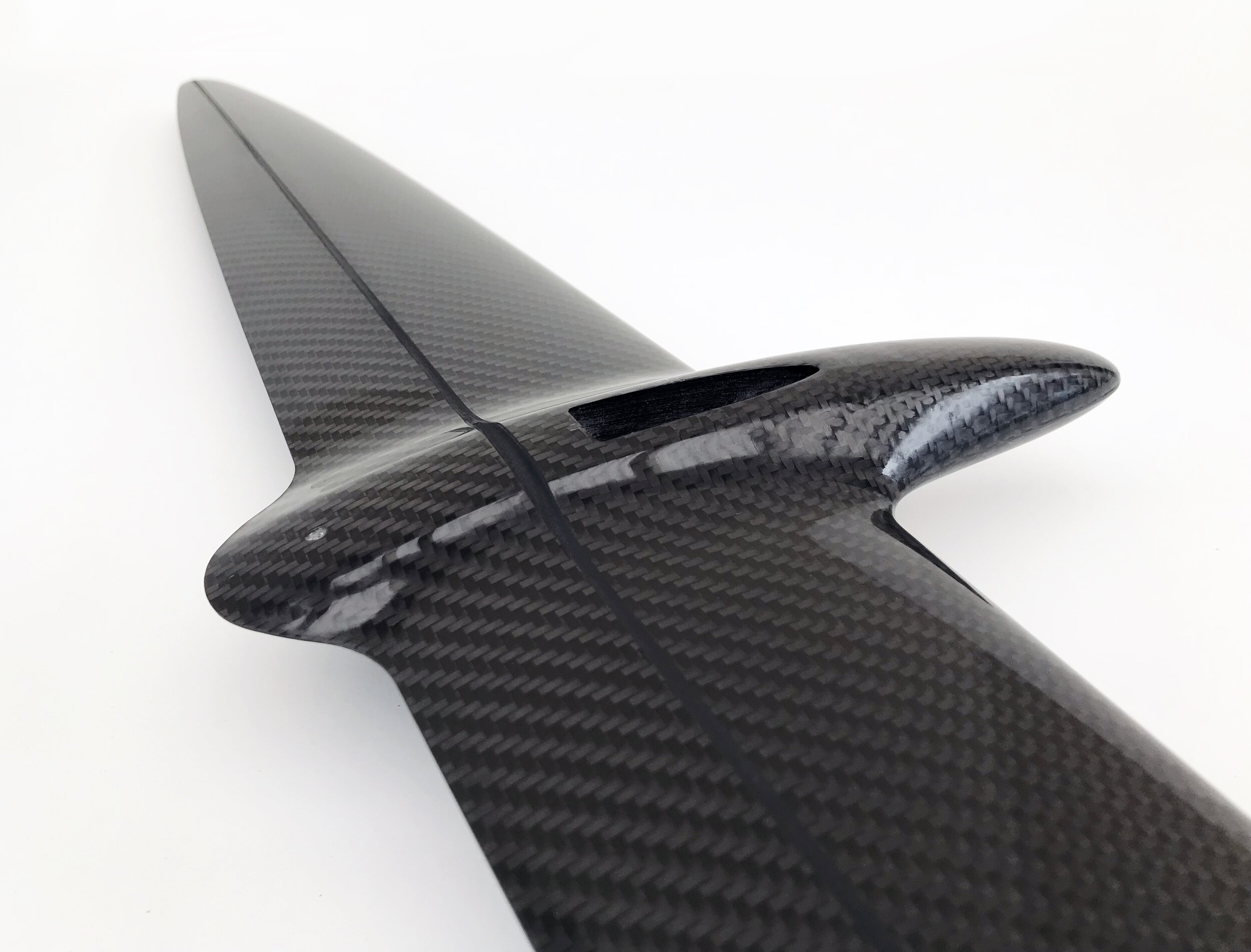
Swift Small (v3)
The ultimate all round medium wind foil, that has been winning regattas since the initial release. It is known for having great control features with a very wide performance window.
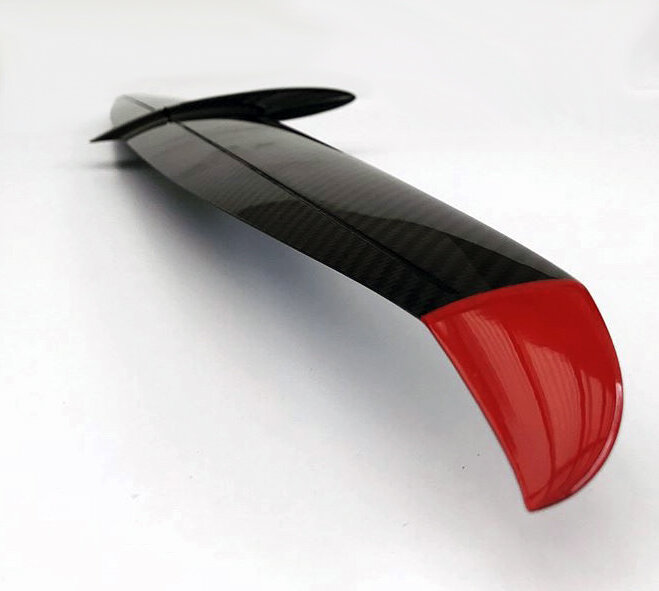
Swift Large (v2)
Excellent high lift foil that can be carried up range thanks to its thin section and very efficient profile. This foil is a proven race winner and a must for heavy sailors or light wind venues.
Swift Rudderfoils
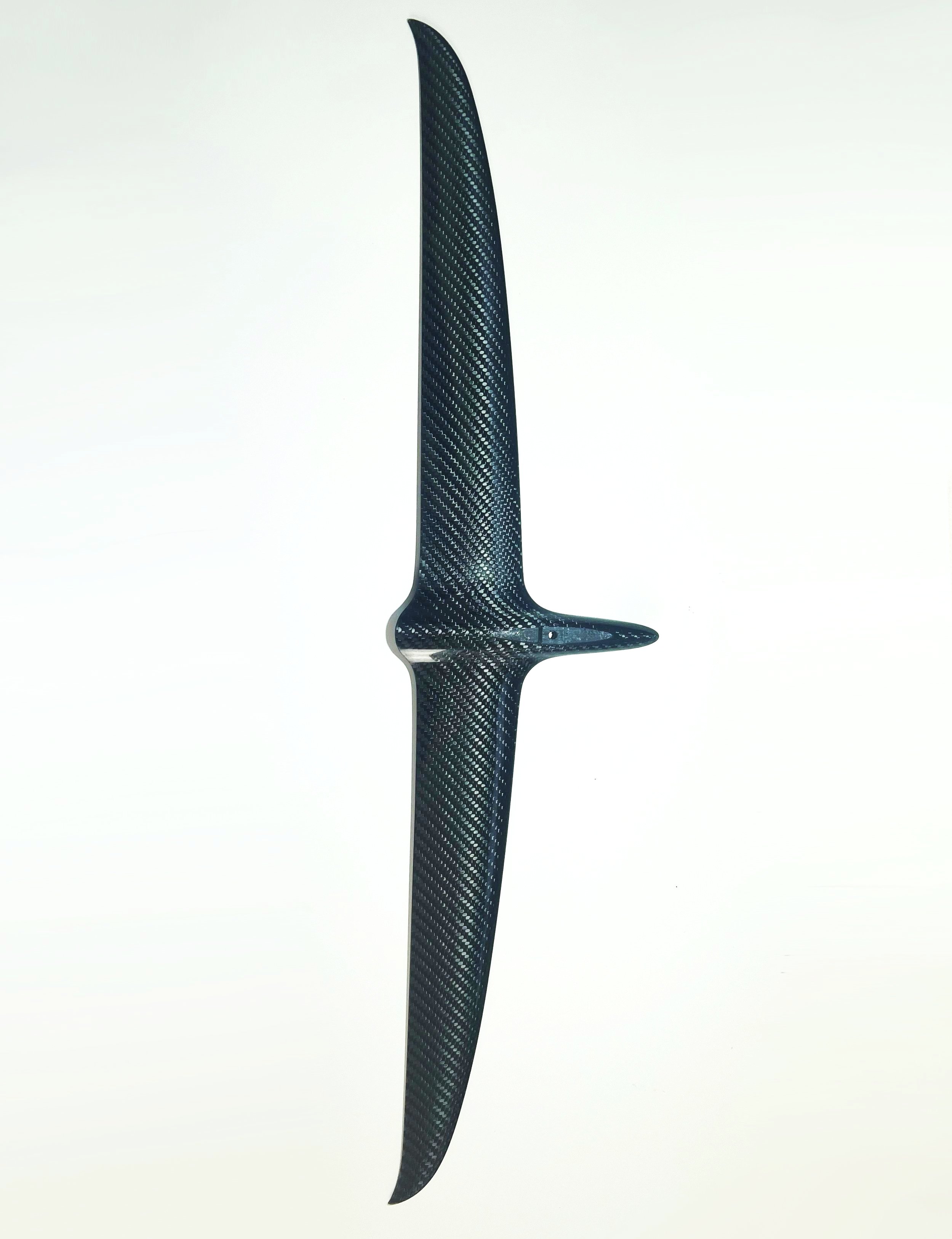
Swift Small Rudder (v1)
The Small rudder is based on the same theory as our Medium. It is a high aspect low drag shape designed to minimise drag and maximise lift offering great glide though ability for ease of foil tacking. Unlike other small rudders, ours still makes foil tacking a breeze while being tiny in size and super fast.
$2,200 AUD + GST
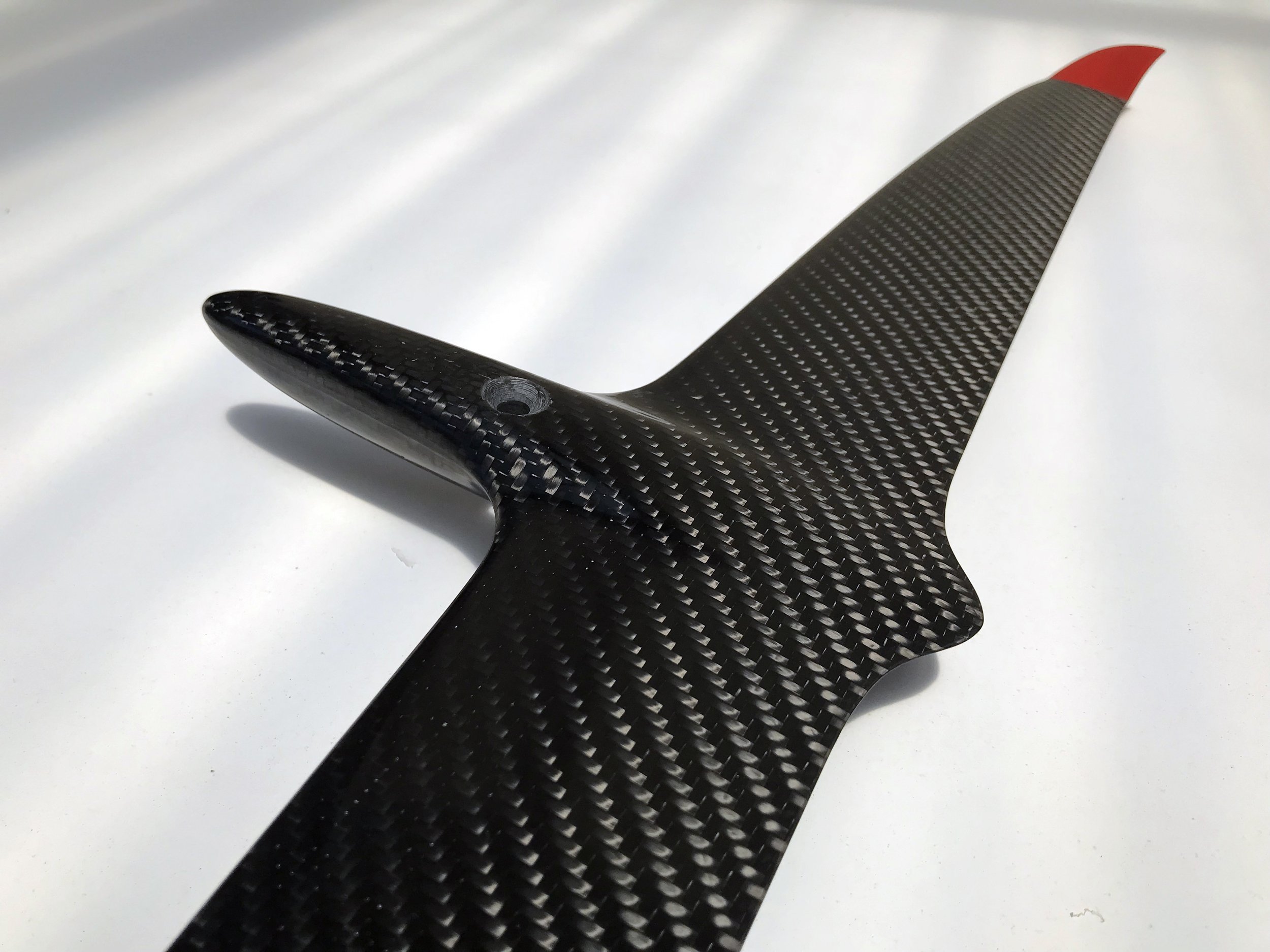
Swift Medium Rudder (v3)
Our Medium rudder is a well proven design that is a result of many years of development. Its short cord makes it very low drag however it generates plenty of lift thanks to its high aspect ratio. This foil will help make your foiling tacks easy and repeatable. $2,200 AUD + GST
Swift Verticals
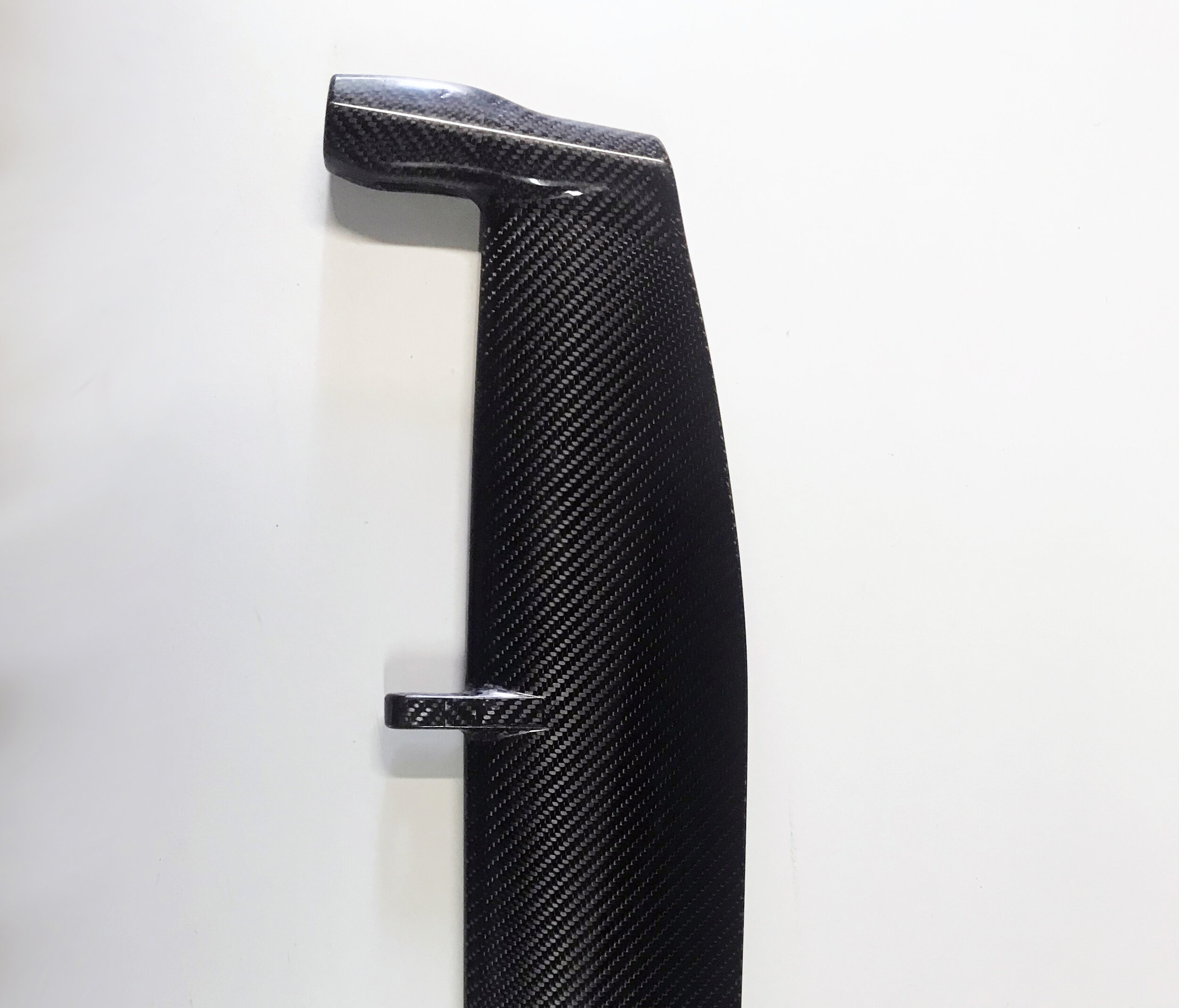
Swift HM Rudder Vertical (v3)
The v3 is our latest design to date. It further improves on the original v1/v2 designs with changes in the bottom 1/4 of the section. It is designed to be on the absolute limit of the materials to insure the ultimate performance from reduction in drag coefficient. It also includes a number of design features that combat the “all too common” rudder wash out problems. Made from pre/preg solid High Modulus carbon fibre construction, it is thermally stable and ultra stiff.
$4,100 AUD + GST
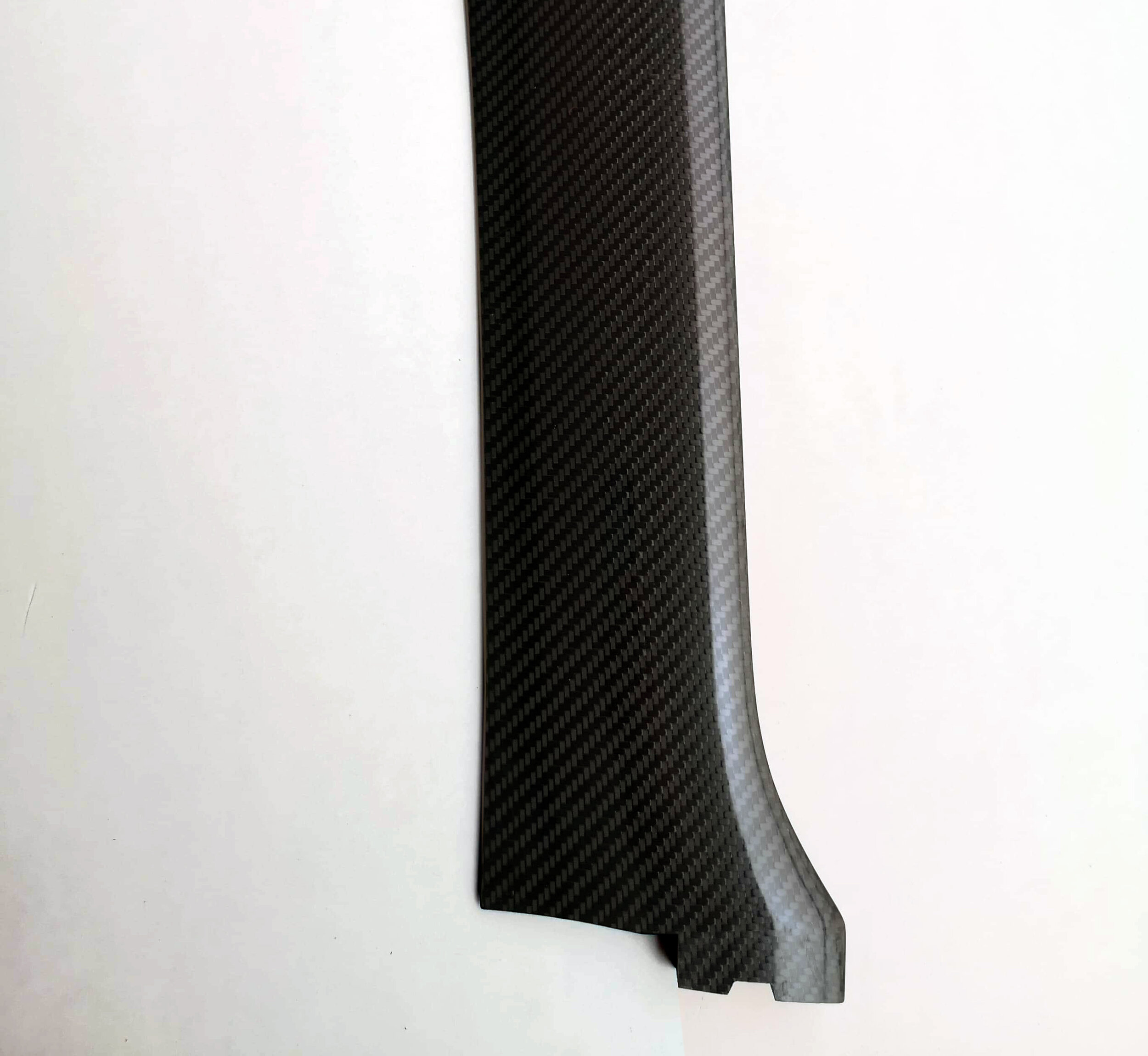
Swift HM Main Vertical (v1)
This is the thinnest main vertical on the market which offers significant reduction in drag by simply being smaller to reducing skin friction and displacement. Made from solid High Modulus carbon fibre construction, it is thermally stable and ultra stiff. Includes pushrod and bellcrank kit.
$4,500 AUD + GST

AOA Templates
These angle of attack measuring templates, are designed to fit our range of Swift main and rudder hydrofoils. With the help of this device, you will be able to determine the all important foil angle relative to waterline. $45 AUD + GST
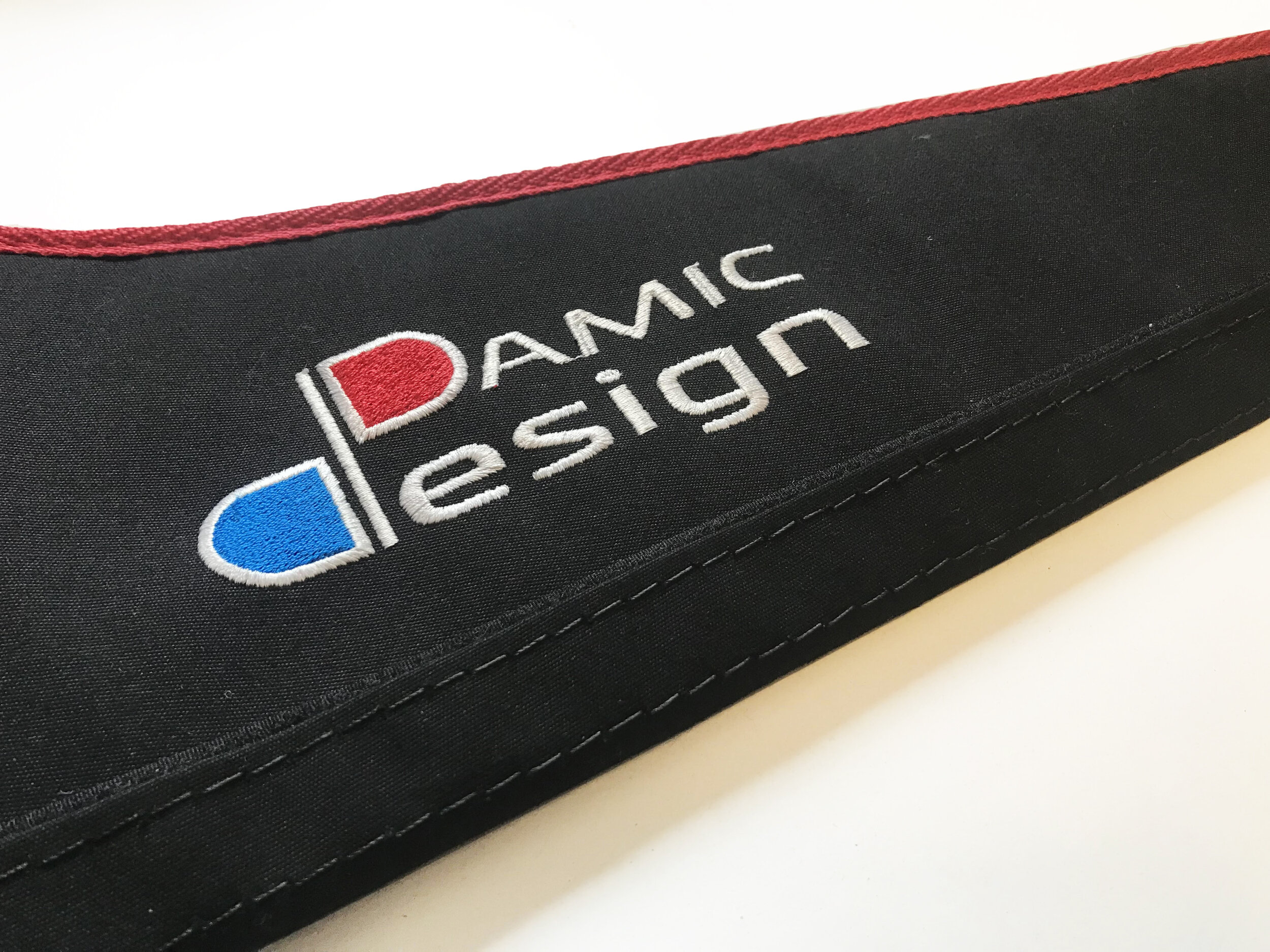
Swift Vertical Covers
Tailor made to suit Swift HM Main verticals and HM Rudder Verticals. These premium quality covers are Australian made using quality Dimension Polyant sailcloth. They features marine canvas outer skin and felt lining inside. $120 AUD + GST
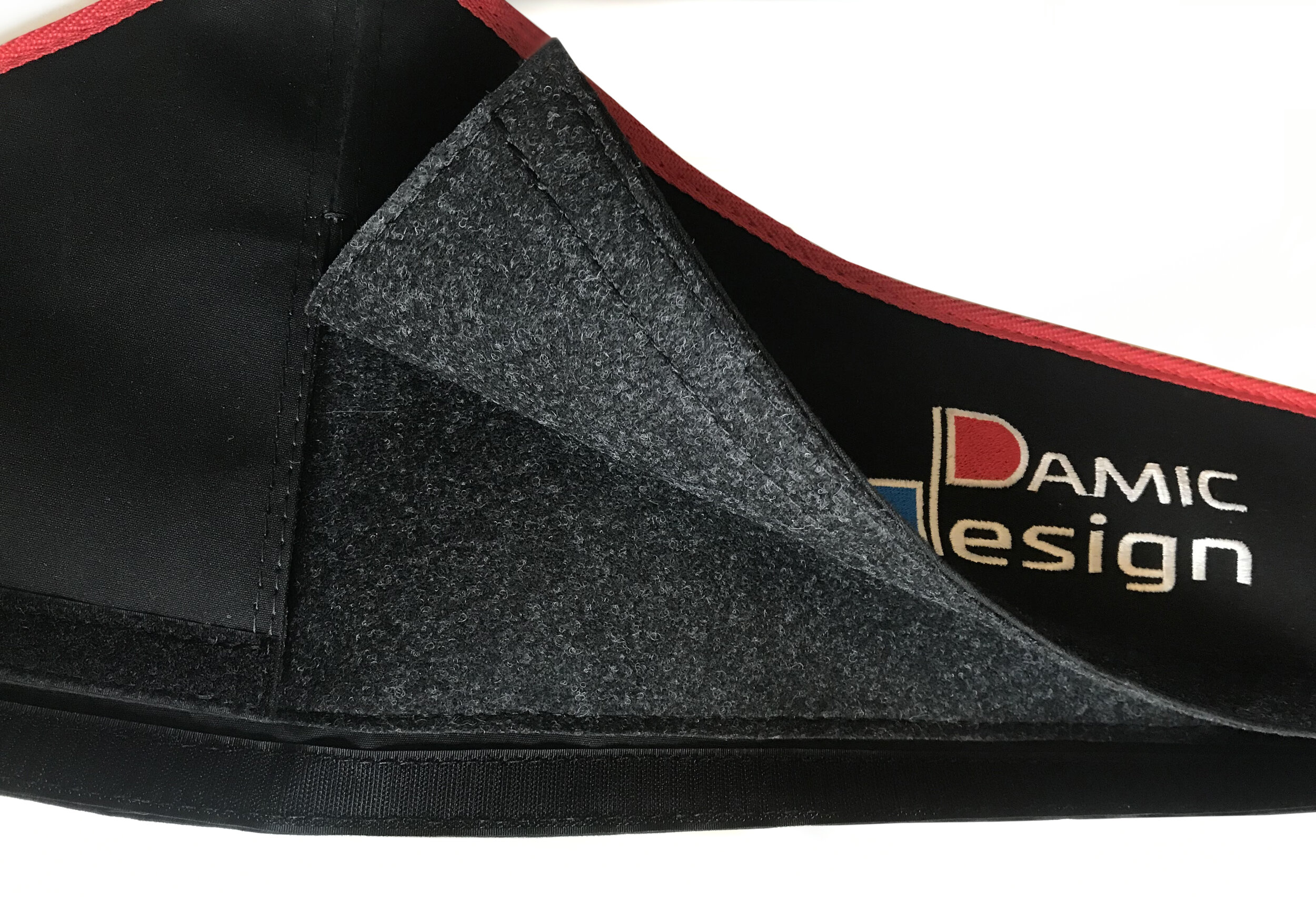
Swift Horizontal Covers
Suitable for Swift Super Small, Small and Large horizontal hydrofoils. These premium quality covers are Australian made using quality Dimension Polyant sailcloth. They features marine canvas outer skin, felt lining inside and Velcro closure to protect the trailing edges. $110 AUD + GST

MACH 2 Price
Mach2.6 pricing information.
When you purchase a MACH2.6 Moth it includes the following:
- stunning carbon fibre clear coated hull,
- high modulus carbon foils (2.4/2.41),
- hi modulus 40mm mast,
- hi modulus bent stiff tapered boom,
- carbon gantry,
- 2.5 aero wings with no compression bars,
- KA MSH5.4 deck sweeper sail,
- all rigging ropes and fittings,
- foil covers,
- boat cover,
- wing tramps with foot straps and
- wooden indoor storage box (option to upgrade to a outdor fiberglass box for US$900)
Due to the wild fluctuation of currencies, cost of materials and shipping, pricing needs to be quoted. For a quote please email: [email protected]
Payment method: We accept payments in US Dollars, Euro, GBP and Australian Dollars. Payments can be made by EFT/IMT to the bank account detailed on the quotation.

Thanks for Visiting the MACH 2 Website
Before you go, sign up to keep up to date with all the latest MACH2 developments.

Featured Sailboat:
Yachting World
- Digital Edition

Waszp – the new one-design foiling Moth that could make learning to fly a little less painful
- Matthew Sheahan
- September 14, 2016
As a development class, the International Moth has been a hotbed of foiling innovations over the past few years. Matthew Sheahan reports on a new accessible one-design version
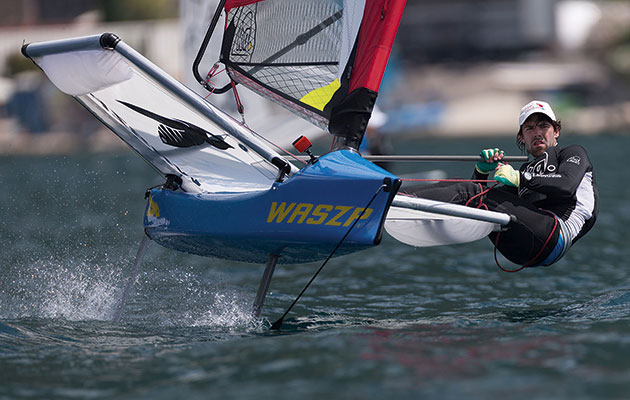
Waszp on display at Foiling Week 2016, Malcesine, Lake Garda. Pic: Gilles Martin-Raget
If there is one class of boat that has turned more heads around the world in the last decade than any other, it must surely be the foiling Moth. Having started as more of a stunt than anything more serious, there is now no other way to race a Moth.
Fleets worldwide have grown and the experts make foiling look effortless, yet the reality is that mastering the Moth is even more difficult than carve gybing a windsurfer. Yet there is no doubt that the combination of speed, silence and extraordinary looks has been, and continues to be, a big draw.
With so few rules, the International Moth – as opposed to the ironing board-shaped British Moth – has always been at the leading edge of design and development. Famous for its laissez-faire approach, it has just a few simple rules that have resulted in some of the most radical thinking in the sport.
But not everyone is able or willing to play. For some, the pace of development got too hot when hull shapes became little more than a plank on edge. A boat that would only float the right way up if you were moving and required the balance of a cat on a fence from the helmsman was a challenge too far for many sailors.
But as we now know, there was another big hike in performance to come as the Moth took to foils. Once again, some found this a step too far, though plenty rose to the challenge and helped to create a completely new style of racing. Those who have learned to foil have left the rest of us green with envy.
One design Moth
But a new design of Moth might change all that as the long-awaited WASZP goes on sale. Conceived five years ago by Andrew McDougall, designer of the MACH2 Moth, the idea was to make a foiling Moth not only cheaper, but easier to sail.
So while the WASZP is based on the foiling Moth and conforms to the few class rules that there are, it differs fundamentally in that it is a strict one-design. But it has other advantages for the less daring.

The stern has greater volume to prevent sinking during low-speed manoeuvres and tacking. This also helps keep the boat on the foils. Pic: Gilles Martin-Raget
For starters, the wings provide sufficient buoyancy to keep the boat the right way up when stopped, and they are also adjustable to allow you to alter the angle by which they rise towards their tips – technically called dihedral.
Setting the wings flatter, that is with less dihedral, is like lowering the stabilisers on a child’s bike. The outboard ends of the wings touch the water and support you before things go pear-shaped.
Looking like a pro
As you get more proficient at keeping the kind of balance that unicyclists take for granted, you increase the dihedral to allow you to sail the boat heeled to windward.
At this point the daggerboard T-foil is hauling you to windward while you look like a pro.
Furthermore, the mast is unstayed, making it simpler to rig and, with no shrouds to act as giant cheese wires, considerably safer when you do take a tumble. The main foil and rudder lift like conventional daggerboards so it’s easier to get on and off the beach.
Fully fledged Moths have a fixed daggerboard and rudder, which are fitted when the boat is on its side, leaving you to swim out into deeper water with the boat in tow like a dog with a stick before you can right it and sail away. The reverse process is required when coming ashore.
Clearly, this is not for everyone. With delicate, expensive carbon foils, you want to get this right from the start. Few do.
The WASZP, however, has foils that can not only be lowered progressively once you’re under way, like a Laser, but are made of alloy with injection-moulded tips, making them far more robust.

A conventional daggerboard and matching T foil rudder make life easier getting afloat and back ashore. Pic Gilles Martin-Raget
Worth the wait
The hull is an epoxy, glass, carbon-infused composite so it is tough, but light, weighing 48kg including foils. And although that’s around 18kg heavier than a modern Moth, the WASZP is the same weight as the RS Aero, which I know from experience is light enough to carry down to the water.
And then there’s the cost. At around US$10,000 (£7,550) it is said to be half the price of a fully tricked MACH2.
The project has been a long time coming, but now it’s here with a fleet racing at the recent Foiling Week held on Lake Garda there’s a buzz going around that it was well worth the wait.
Design features

One of the keys to the WASZP is the folding wings. Set horizontally, they act as stabilisers and can be raised as you become more proficient, using different-sized wing supports. Pic Gilles Martin-Raget

Different sail plans for different sizes and abilities of sailor have become popular in modern single-handed dinghies. The WASZP has a choice of 5.8 sq m, 6.9sq m or 8.2sq m sails. Photo Gilles Martin-Raget

A wishbone boom system, like that on a windsurfer, dispenses with a conventional boom and kicker and makes tacking easier. Pic Gilles Martin-Raget

As with the Moth, the WASZP uses a wand to control the ride height automatically using a mechanical sensor system. Pic Gilles Martin-Raget

With its unstayed mast it is easy to rig, there’s no rigging to collide with when you take a tumble and it’s easier to get back aboard after a capsize. Pic Gilles Martin-Raget

Extruded alloy sections and the mechanical hinge systems make for a simpler and more robust system than the composite foils in a Moth. They are also cheaper to replace. Pic Gilles Martin-Raget

A concave profile bow allows better response in waves for the wand while providing greater volume forward to help prevent burying the bow during a bear away. Pic Gilles Martin-Raget


IMAGES
VIDEO
COMMENTS
2010 Foiling moth Ninja - 3760 Great entry level boat for learning to foil, located at Farmoor reservoir, Oxford Complete and ready to sail, comes with: Elite main foil Elite rudder - recently strengthened and made to fit the larger, stronger tillers of newer boats by Shock New tiller system from Shock, used 3 times 2 sails, both with repairs and only for training: Hyde KA 16.3 Mach 2 stiff ...
Classic Moth Boats are a class of small fast singlehanded racing sailboats that originated in the US in 1929 by Joel Van Sant in Elizabeth City, NC. The Classic Moth is a monohull development class...
Classic Moth Boats are a class of small fast singlehanded racing sailboats that originated in the US in 1929 by Joel Van Sant in Elizabeth City, NC. The Classic Moth is a monohull development class using a modified version of the International Moth rule in effect pre 1969. With an eleven foot over-all length, a maximum beam of 60 inches, a ...
For Sale: Harry Cates-built Florida design Classic Moth Boat, Nr 2496. Wood hull, wood blades and boom; aluminum mast. Located in Wilmot, New Hampshire. Asking $1200.00. Contact Bill Herrick < [email protected] >.
For many people looking to get into moth sailing, a well setup used boat is the best place to start. Check out the Moth Buy & Sell Facebook marketplace to get a feel for what boats are in your price range and feel free to reach out using to the contact us tool at the bottom of this page if you have questions about what to look for when buying a used boat.
moth buy & sell. 6.8K members. Moth class boats and spares for sale. Mach 2, Exocet, Rocket, Voodoo, Lennon sails, ka sails, etc. Only members can see who's in the group and what they post. Anyone can find this group. Group created on October 12, 2015. See more.
Basically you get what you pay for. There are a lot of second hand boats on the market but there is also a growing numbers of moth builders. Moth Mart (second hand) Aardvark Racing - Rocket. Fluid Composites - Maverik. Mackay Boats - Bieker. Garda Carbon Lab - Manta. McDougall McConaghy - Mach 2. Maguire Boats - Exocet.
The Moth is a small development class of sailing dinghy.Originally a small, fast home-built sailing boat designed to plane, since 2000 it has become an expensive and largely commercially produced boat designed to hydroplane on foils though many are still built at home, typically at much lower cost.. The pre-hydrofoil design Moths are still sailed and raced, but are far slower than their foiled ...
Amidst intense intra-class squabbling, Rohan Veal used the Iletts' creation to win the 2004 Moth World Championship with eight firsts in eight races. In one race, he beat the second place boat ...
Moth Magic: The Thrilling World of Used Moth Sailboats Used Moth sailboats offer an exhilarating sailing experience for enthusiasts seeking a unique adventure. From their high-speed capabilities to their nimble maneuvering, these vessels combine technology and skill to create an unforgettable ride. Delve into the world of used Moth sailboats and discover the magic of flying across the water in ...
World Sailing - Moth is the official website of the International Moth Class Association, a high-performance sailing class that features hydrofoils and foiling techniques. Learn more about the history, events, rules and news of this exciting and innovative sailing class.
McConaghy Boats: 2015: 7800€ Moth International Autre marque for sale in Neufchâtel-Hardelot-2009: 5600€ Moth International McConaghy Boats for sale in Calais. McConaghy Boats: 2012: 15000€ Moth International Mackay Boats for sale in Niort. Mackay Boats: 2019: 7500€ Moth International Other brand à vendre à Londo-2018: 7800€
About the Boat. The international Moth Class is the fastest one Person Dinghy in the World. Key Facts: Maximum Length: 3.355 m. Maximum Beam: 2.250 m. Total Weight: Unrestricted (~ 35-40 Kg) Maximum Sail Area: 8.25 m². Optimum Skipper Weight: 60-80 Kg.
Max vang should be achieved in 15 knots and max cunningham in 18 knots. The Moth gets overpowered quickly, and from 18 knots upwards a softer tip or different sail is required. North's LA and DS designs have a slight variation in the luff rounds to cover the range, with the DS being aimed at 14 knots true wind speed.
McConaghy Boats: 2015: 7800€ Moth International Autre marque for sale in Neufchâtel-Hardelot-2009: 5600€ Moth International McConaghy Boats for sale in Calais. McConaghy Boats: 2012: 15000€ Moth International Mackay Boats for sale in Niort. Mackay Boats: 2019: 7500€ Moth International Other brand à vendre à Londo-2018: 7800€
The MOTH, raced today (2015), at the top tier of competition is a 'foiler' with wings. Sailboat Forum. View All Topics: ... A Ballast/Displacement ratio of 40 or more translates into a stiffer, more powerful boat that will be better able to stand up to the wind. Bal./Disp = ballast (lbs)/ displacement (lbs)*100
Comfort Ratio. This ratio assess how quickly and abruptly a boat's hull reacts to waves in a significant seaway, these being the elements of a boat's motion most likely to cause seasickness. Read more. Formula. 0.64. <20: lightweight racing boat. 20-30: coastal cruiser. 30-40: moderate bluewater cruising boat.
Lay foam onto mould, tape or tack in place with small nails or staples, add a layer of Peel Ply, then vacuum again. Once this has set, remove from bag and Peel Ply, ensure surface is smooth, then wet foam out with resin. Lay one layer of 200g plan at 0 degrees of centreline, Peel Ply and vacuum.
Swift Hydrofoils. Damic Design specialises in design and manufacturing of Moths and Hydrofoils for the International Moth Class. While Moth sailing is our passion, our main objective is to offer the fastest, most developed and best built boats and foils on the market. Our involvement in the class started in 2004, exposing us to the world of ...
When you purchase a MACH2.6 Moth it includes the following: stunning carbon fibre clear coated hull, high modulus carbon foils (2.4/2.41), hi modulus 40mm mast, ... 2.5 aero wings with no compression bars, KA MSH5.4 deck sweeper sail, all rigging ropes and fittings, trolley, foil covers, boat cover, wing tramps with foot straps and; wooden ...
Sailboat Listings include racers, cruisers, sloops, catamarans, trimarans, daysailers, sailing dinghies, and overnighters in our photo ads of used sailboats for sale. View All Sailboats. ... Much more stable than the Waszp and much more durable than a Moth, more modern than a UFO. Skeeta has a durable efficient scow hull constructed similar to ...
But a new design of Moth might change all that as the long-awaited WASZP goes on sale. Conceived five years ago by Andrew McDougall, designer of the MACH2 Moth, the idea was to make a foiling Moth ...
Featured Sailboats (all): 31' Catalina 3155 Muskegon, Michigan Asking $146,000. 17' owner built Gaff rig cutter Schenectady SCOTIA, New York Asking $12,000. 36' Hinterhoeller Nonsuch San Diego, California Asking $89,500. 38' Catalina 38 Portland, Oregon Asking $35,000. 40' Dragonfly 1200 Alameda, California